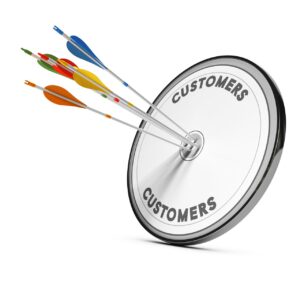Are you a field sales professional looking to drive revenue and build strong customer relationships? Our comprehensive guide is here to help. Discover 10 quick win strategies that go beyond the basics, empowering you to enhance your prospecting efforts.
Inside this guide, you’ll find effective strategies to streamline your prospecting process, boost conversion rates, and achieve your sales team goals. Each strategy equips you with the necessary tools and techniques to outperform the competition and maximize revenue. From defining your ideal client profile to leveraging technology, we’ll provide actionable steps to revolutionize your prospecting approach.
Ready to unlock your potential for success in field sales prospecting? Let’s get started with these 10 quick-win strategies.
Strategy 1: Define Your Ideal Customer Profile
Defining your ideal consumer profile involves determining the characteristics of customers who are most likely to purchase from you. This includes analyzing your existing customer base to identify commonalities such as industry, company size, job titles, and pain points. By creating a profile that represents your ideal market, your sales reps can focus your efforts and resources more effectively.
Defining your ideal customer profile is essential for improving your field sales prospecting because it allows you to concentrate on prospects with a higher potential for conversion.
By understanding the characteristics of your ideal consumers, you can tailor your messaging, targeting, and prospecting strategies to resonate with their needs. This leads to more effective prospecting, higher-quality leads, and increased success rates.
Tips, Tricks, and Techniques
- Existing Customer Base Assessment: Look for commonalities among your successful clients. Analyze their industry, company size, job titles, and pain points to identify patterns and trends that represent your ideal market profile.
- Data and Tools Utilization: Make use of tools like LinkedIn Sales Navigator and ZoomInfo to gather insights and create a list of potential clients who match your ideal customer profile. These resources provide valuable data to enhance your sales team’s prospecting strategies.
- Message Personalization: Once you have defined your ideal consumer profile, customize your messaging and outreach efforts to address their specific pain points and needs. Personalize your communication to resonate with their challenges and show how your product or service can provide solutions.
- Targeting Strategy Refinement: Use your ideal client profile to refine your targeting strategies. Focus on prospecting within industries, companies, and job titles that align with your ideal audience characteristics. This ensures that the efforts of sales reps are directed toward prospects who are more likely to convert.
- Continuous Reviews and Updates: Regularly review and refine your ideal customer profile based on new insights and feedback. As your business evolves and market dynamics change, update your profile to remain aligned with your target audience.
- Insights Sharing and Collaboration: Communicate your ideal lead profile to your sales team to make sure everyone is aligned. Sharing insights and knowledge about your ideal customers empowers your team to effectively prospect and engage with prospects who match the profile.
- Measurement and Adjustment: Continuously measure the success of your sales reps’ prospecting efforts and adjust your sales team’s strategies based on the results. Monitor key metrics such as conversion rates, lead quality, and revenue generated to gauge the effectiveness of your ideal customer profile.
- Adaptation and Enhancement: Stay open to adapting and evolving your ideal customer profile as your business and market conditions change. Stay informed about shifts in consumer needs, industry trends, and market dynamics to ensure your profile remains relevant and effective.
Strategy 2: Harness the Power of Technology
Harnessing the power of technology in field sales prospecting involves utilizing various tools, platforms, and software to streamline and enhance your sales team’s prospecting efforts.
This includes leveraging customer relationship management (CRM) systems, sales prospecting software, email automation tools, social media platforms, and other digital resources to optimize your prospecting process.
Harnessing technology is crucial for improving field sales prospecting as it increases efficiency, productivity, and effectiveness. It enables your sales team to manage and track leads, automate outreach efforts, personalize communication at scale, engage with prospects on social media, and leverage data for informed decision-making.
By utilizing the right technology, sales reps can optimize your prospecting process, save time, and focus on the most promising leads.
Tips, Tricks, and Techniques
- CRM System: Such a system enables you to track progress, monitor communication history, and make sure no opportunities fall through the cracks. Choose one that suits your business needs and integrates well with your prospecting workflow.
- Sales Prospecting Software: Such software enables sales reps to identify potential clients based on specific criteria such as company size, industry, and job title. These tools automate outreach efforts, personalize communication, and save valuable time.
- Email Automation Tools: These tools allow sales teams to send personalized emails at scale, schedule follow-ups, and track engagement. Automating your email campaigns helps you nurture leads effectively, maintain consistent communication, and save time on manual follow-ups.
- Social Media Platforms: Develop a strong presence on platforms where your target audience is most active. Engage with your audience by sharing valuable content, commenting on their posts, and initiating conversations.
- Advanced Search Features: Use filters such as industry, job title, location, and company size to narrow down your search. This targeted approach enables you to connect with prospects who are most likely to be interested in your offerings.
- Technology Trends: Attend webinars, read industry blogs, and join relevant communities to expand your knowledge and discover new tools that can enhance your prospecting efforts.
- Technology Integration: Make sure your sales team is trained on how to effectively use the tools and leverage their capabilities. Integrate the data and insights from technology platforms with your CRM system for a comprehensive view of your prospecting activities.
- Evaluation and Updates: Assess their impact on your prospecting efforts and make adjustments or switch to new tools if necessary. Stay agile and open to adopting new technologies that can further optimize your prospecting process.
Strategy 3: Prioritize Your Leads
Prioritizing your leads means categorizing and ranking them based on their likelihood to convert into clients. It involves assessing the quality and potential of each lead and determining the order in which you should focus your efforts and resources. Prioritizing leads helps you allocate your time and energy more efficiently, focusing on leads that are most likely to generate revenue.
Prioritizing your leads improves your field sales prospecting by ensuring that you invest your time and resources wisely. By focusing on leads with a higher likelihood to convert, you increase your efficiency, improve your conversion rates, and optimize your sales pipeline. Prioritization allows you to allocate your efforts where they will yield the best results, ultimately improving your overall prospecting outcomes.
Tips, Tricks, and Techniques
- Ideal Customer Criteria: Clearly define the characteristics of your ideal customer based on industry, product/service offering, and historical data. Consider factors such as company size, industry, job title, geographic location, and pain points.
- Lead Scoring System: Create a lead scoring system to rank your leads based on their likelihood to convert. Assign points to each lead based on their alignment with your ideal client criteria. Consider factors such as their level of engagement, budget, authority, and timeline.
- High-Priority Leads: Invest your time and effort in nurturing high-priority leads with higher scores. These leads are more likely to convert and generate revenue.
- Re-evaluation and Updates: Periodically review and update your lead scoring system as your business evolves and market conditions change. Stay flexible and adjust the weights and criteria to reflect the most current trends and insights.
- Lead Qualification Techniques: Develop lead qualification techniques that help you assess the quality and potential of each lead. Use methods such as BANT (Budget, Authority, Need, and Timeline) to determine if a lead meets the criteria for further pursuit.
- Data and Analytics: Leverage data and analytics to gain insights into lead behavior and engagement. Monitor metrics such as email open rates, click-through rates, website interactions, and social media engagement.
- Marketing Collaboration: Collaborate closely with your marketing team to align on lead scoring criteria and make sure a smooth handoff between marketing and sales.
- Lower-Priority Leads: While focusing on high-priority leads, it’s important not to neglect the lower-priority leads entirely. Implement lead nurturing strategies to engage with and cultivate relationships with these leads over time.

Strategy 4: Leverage the Influence of Social Media
Leveraging the influence of social media in field sales prospecting means utilizing social media platforms to connect, engage, and build relationships with your target audience. It involves leveraging platforms such as LinkedIn, Twitter, Facebook, and Instagram to expand your reach, establish credibility, and generate leads.
Social media allows you to share valuable content, interact with prospects, and position yourself as a trusted authority in your industry.
Leveraging the influence of social media in your field sales prospecting efforts helps you reach a broader audience, build relationships, and establish credibility. It provides a platform for sharing valuable content, engaging with prospects, and showcasing your expertise.
By effectively utilizing social media, sales reps can increase your visibility, attract prospects, and generate leads, ultimately improving your field sales prospecting outcomes.
Tips, Tricks, and Techniques
- Identify the Right Platforms: Determine the social media platforms where your target audience is most active. For B2B sales, LinkedIn is often the platform of choice, while B2C sales may benefit from a presence on platforms like Facebook and Instagram.
- Optimize Your Profiles: Use high-quality images and keywords relevant to your industry. Craft a strong bio or summary that clearly communicates your value to potential consumers. An optimized profile attracts prospects and establishes credibility.
- Share Valuable Content: Position yourself as a thought leader by sharing industry insights, best practices, and useful tips. Use a mix of original content, curated articles, and industry news to provide maximum value to your audience.
- Engage With Your Audience: Actively engage with your target audience by commenting on their posts, responding to messages and inquiries, and participating in relevant discussions. Building authentic relationships through engagement leads to trust and increased sales opportunities.
- Leverage Groups and Communities: Join industry-specific groups and communities on platforms like LinkedIn and Facebook. These groups offer opportunities to build relationships with like-minded professionals and gain visibility within your target market.
- Utilize Advanced Search Features: Use filters such as industry, job title, location, and company size to narrow down your search. This targeted approach enables you to connect with prospects who are most likely to be interested in your offerings.
- Personalize Your Outreach: When reaching out to prospects, personalize your messages to demonstrate that you have done your research and understand their specific needs. Reference their recent posts or articles they shared and explain how your product or service can help.
- Measure and Optimize: Track the performance of your social media efforts by monitoring engagement metrics such as likes, comments, shares, and click-through rates. Analyze the data to identify the types of content and strategies that resonate most with your audience.
Strategy 5: Master the Art of Cold Calling
Mastering the art of cold calling involves developing the skills, techniques, and strategies to make effective and engaging cold calls. It requires a thoughtful approach and the ability to navigate conversations with prospects who may not be familiar with your product or service. Mastering cold calling helps you initiate meaningful conversations, build relationships, and uncover valuable sales opportunities.
Mastering the art of cold calling helps improve your field sales prospecting by providing a direct and proactive way to engage with prospects. It allows you to initiate conversations, build rapport, and identify potential leads who may not have been reached through other prospecting methods. By honing your cold calling skills, you can maximize your chances of success and generate valuable leads.
Tips, Tricks, and Techniques
- Prospects Research: Before making a cold call, invest time in researching your prospects. Understand their industry, challenges, and pain points. Use tools like LinkedIn, company websites, and industry publications to gather relevant information.
- Value Proposition: Craft a clear and compelling value proposition that highlights the unique benefits of your product or service. Communicate how it addresses your prospects’ pain points and delivers value to their organization.
- Preparation and Confidence: Approach cold calling with confidence and a positive mindset. Practice your pitch to make sure you convey your message clearly and effectively. Anticipate potential objections and prepare persuasive responses.
- Professionalism and Positivity: Objections are a natural part of cold calling. Embrace them as an opportunity to address your prospect’s concerns and showcase your expertise. Listen attentively, empathize with their perspective, and provide thoughtful responses.
- Planned Approaches: Every cold call should have a clear next step. Whether it’s scheduling a follow-up meeting, sending additional information, or arranging a product demonstration, guide the conversation towards a specific action.
- Active Listening: Actively listen to your prospects during cold calls. Pay attention to their tone, language, and the information they share. By listening attentively, you can uncover valuable insights, build rapport, and tailor your pitch to address their specific needs.
- Personalized Approach: Cold calling doesn’t have to be impersonal. Personalize your calls by referencing something specific to the prospect or their organization. This demonstrates that you’ve done your homework and increases the likelihood of a positive response.
- Follow-Up and Follow-Through: After a cold call, promptly follow up with any commitments or promises made during the conversation. Send relevant information, schedule follow-up meetings, or provide additional resources as promised. Following through on your commitments shows professionalism and builds trust with your prospects.
Strategy 6: Foster Strong Relationships
Fostering strong relationships in field sales prospecting means establishing connections based on trust, credibility, and mutual understanding with your prospects. It involves actively listening to their needs, providing value, and demonstrating your expertise. Fostering strong relationships goes beyond transactional interactions and focuses on becoming a trusted partner in your prospects’ success.
Fostering strong relationships improves your field sales prospecting by establishing trust and rapport with your prospects. When you develop strong relationships, you differentiate yourself from competitors and become more than just a salesperson. Building relationships allows you to understand your prospects’ needs better, provide tailored solutions, and increase your chances of closing deals.
Tips, Tricks, and Techniques
- Practice Active Listening: When interacting with prospects, practice active listening. Focus on understanding their needs, challenges, and goals. By listening attentively, you can tailor your solutions to meet their specific requirements.
- Ask Thoughtful Questions: To gain a deeper understanding of your prospects, ask thoughtful questions that go beyond surface-level information. Ask about their goals, pain points, and aspirations. By asking probing questions, you demonstrate your genuine interest.
- Provide Value: Offer valuable information, insights, and resources that are relevant to your prospects’ industry or pain points. This could include industry reports, whitepapers, or relevant blog articles. By providing value upfront, you establish yourself as a trusted advisor and build credibility.
- Responsive and Reliable: Promptly respond to inquiries and follow up on promises. Show your prospects that their time and needs are valuable to you. Being reliable and responsive builds trust and enhances the overall relationship.
- Personalized Communication: Tailor your communication to each prospect. Use their name, reference previous conversations or interactions, and demonstrate your understanding of their unique challenges. Personalization shows that you value the relationship and are invested in their success.
- Authentic and Genuine: Authenticity goes a long way in building relationships. Be sincere, honest, and transparent in your interactions. People appreciate genuine connections and are more likely to trust and engage with someone they perceive as authentic.
- Long-Term Relationships: Stay in touch, provide ongoing support, and check in with your customers to ensure their satisfaction. Long-term relationships lead to repeat business, referrals, and expanded opportunities.
- Relationship Management: Utilize customer relationship management (CRM) systems and other technology tools to manage and track your interactions with prospects and customers. This helps you stay organized, follow up effectively, and provide personalized attention.
Strategy 7: Continuous Learning and Development
Continuous learning and development in field sales prospecting refer to the ongoing process of acquiring new knowledge, skills, and insights to improve as a sales professional. It involves staying updated with industry trends, refining techniques, and expanding expertise to adapt to changing market dynamics.
Continuous learning and development are crucial for improving field sales prospecting by keeping sales reps informed, adaptable, and competitive. It helps you stay ahead of industry trends, understand customer needs, and refine strategies for better prospecting outcomes.
By investing in your professional growth, you enhance your capabilities and increase your chances of success.
Tips, Tricks, and Techniques
- Attend Industry Events: Participate in conferences, trade shows, and seminars. These events offer networking opportunities and insights from experts. Engage in workshops and panel discussions to enhance knowledge and skills.
- Read Industry Publications: Subscribe to industry-specific publications, blogs, and newsletters. Stay informed about the latest news, insights, and best practices. Reading industry publications keeps you up-to-date with trends and innovative approaches.
- Invest in Training and Development: Take advantage of training programs, workshops, and online courses. Look for programs covering various prospecting aspects. Continuous improvement of knowledge and capabilities helps adapt to changing market dynamics.
- Seek Feedback and Mentorship: Actively seek feedback from mentors, colleagues, or superiors. Their insights can help identify areas for improvement and provide guidance on refining prospecting strategies. Embrace constructive criticism for growth.
- Share Best Practices: Collaborate with peers and share best practices within your organization or industry. Engage in discussions, brainstorm ideas, and learn from experiences. Sharing knowledge helps gain fresh perspectives and discover new approaches.
- Embrace Online Learning Platforms: Explore online learning platforms offering sales and prospecting courses and resources. Platforms like LinkedIn Learning, Udemy, and Coursera provide a wide range of courses on sales techniques and communication skills.
- Join Professional Associations: Become a member of professional sales associations or industry-specific organizations. They provide access to resources, networking opportunities, and educational events. Engaging with professionals allows for learning from experiences and staying connected with industry trends.
- Seek Cross-Functional Collaboration: Collaborate with colleagues from different departments to gain a holistic understanding of the customer journey. Engaging in cross-functional collaboration broadens perspectives and provides valuable insights to enhance prospecting strategies.

Strategy 8: Measuring Success
Measuring success in field sales prospecting involves tracking and evaluating key performance indicators (KPIs) to assess the effectiveness of your prospecting efforts. It helps understand the impact of strategies, identify areas for improvement, and make data-driven decisions to optimize the prospecting process.
Measuring success is crucial for improving field sales prospecting as it provides valuable insights into what is working and what needs adjustment. By analyzing data and metrics, you can identify trends, evaluate prospecting performance, and make informed decisions to enhance results. Measuring success enables optimizing strategies and allocating resources effectively.
Tips, Tricks, and Techniques
- Key Performance Indicators (KPIs): Determine relevant KPIs aligned with prospecting goals. Common KPIs include new leads generated, conversion rates, average deal size, sales cycle length, and customer acquisition cost.
- Regular Reviews: Schedule regular reviews to analyze prospecting metrics and evaluate performance. Monthly, quarterly, or yearly reviews identify trends, patterns, and areas for improvement.
- Adjustment and Optimization: Based on the review findings, make necessary adjustments and optimizations to the prospecting strategy. Continuously optimize the approach to align with changing market dynamics.
- A/B Testing: Test different prospecting tactics to identify what resonates best. Collect data and analyze results to determine strategies with high conversion rates.
- CRM Analytics: Leverage CRM analytics to gain insights into prospecting activities. Analyze data related to lead engagement, conversion rates, and pipeline progression.
- Sales Team and Business Goals: Ensure prospecting metrics align with the sales team and overall business goals. Demonstrate the impact of prospecting efforts on the organization’s success.
- Milestones and Achievements: Recognize and celebrate milestones and achievements in prospecting efforts. Share success stories with the team and use achievements as motivation for improvement.
Strategy 9: Embrace Referral Marketing
Embracing referral marketing in field sales prospecting involves leveraging satisfied customers’ recommendations to generate high-quality leads. It entails actively seeking referrals and establishing systems and incentives for customers to refer contacts to the business.
Embracing referral marketing can significantly improve field sales prospecting by tapping into satisfied customers’ networks. Referrals carry trust and credibility, making them more likely to convert into customers. By leveraging word-of-mouth, the reach can be expanded, lead quality increased, and conversion rates enhanced.
Tips, Tricks, and Techniques
- Delight Existing Customers: Provide exceptional products, services, and customer experiences to encourage referrals.
- Develop a Referral Program: Create a structured program incentivizing and rewarding customers for successful referrals.
- Educate Customers: Proactively communicate the value of the referral program and provide resources for seamless referrals.
- Personalize Referral Requests: Highlight specific reasons why their network could benefit from the business.
- Leverage Digital Channels: Utilize email marketing and social media to promote the referral program and make sharing easy.
- Follow up and Express Gratitude: Promptly follow up with both the referrer and the referred lead, providing exceptional service.
- Measure and Optimize: Track the success of the referral program, analyze data, and make necessary adjustments for optimization.
Strategy 10: Cultivate Strategic Partnerships
Cultivating strategic partnerships in field sales prospecting involves collaborating with businesses or professionals offering complementary products or services. By combining resources, expertise, and networks, strategic partnerships allow for expanded reach and mutually beneficial lead generation.
Cultivating strategic partnerships enhances field sales prospecting by tapping into partners’ strengths and networks. It enables access to new customer bases, credibility through association, and mutually beneficial lead-generation opportunities.
Tips, Tricks, and Techniques
- Finding Complementary Partners: When seeking strategic partnerships, look for businesses whose products or services complement yours without direct competition. Identifying partners with compatible offerings can create synergy and expand your market reach.
- Assessing Compatibility: Before entering into a partnership, make sure alignment in values, quality standards, and a customer-centric approach. Assessing compatibility establishes a strong foundation for collaboration and builds trust between partners.
- Establishing Connections: Take the initiative to start conversations with potential partners to explore collaboration opportunities. By reaching out proactively, you can discover shared goals, interests, and areas of synergy.
- Aligning Goals and Expectations: Effective collaboration requires aligning objectives, and target audience, and establishing clear guidelines. Defining mutual goals and expectations enables partners to work efficiently and effectively together.
- Creating Joint Marketing Initiatives: Foster collaboration through joint marketing efforts that leverage each partner’s strengths. Co-create content, host webinars or workshops, and run joint campaigns to amplify your message and attract a broader audience.
- Encouraging Referrals and Recommendations: Actively refer your partners to your network and encourage them to do the same. By endorsing and recommending each other, you tap into new customer bases and benefit from the trust established through referrals.
- Nurturing Partnerships: Continuously monitor lead quality, assess collaboration levels, and proactively address challenges. Nurturing partnerships requires ongoing communication, mutual support, and a commitment to shared success.

Final Thoughts | Supercharge Your Field Sales Prospecting
Implementing these ten powerful strategies can drive your sales success to new heights and deliver quick wins in your field sales prospecting.
Success in field sales prospecting requires a proactive and targeted approach. Align your efforts with the needs and preferences of your ideal customers, streamline your processes with technology, and build meaningful relationships to optimize your prospecting and boost conversion rates.
Continuously learn and measure your success, while leveraging the power of referrals and partnerships to stay ahead of the competition and maximize sales opportunities.
So, embrace these strategies with confidence and determination. Embrace the challenges, adapt to the changing landscape, and unlock the full potential of your field sales prospecting. Your success is within reach!
Frequently Asked Questions
How can I identify my ideal customer profile?
To identify your ideal customer profile, analyze your existing customer base for commonalities and leverage data and tools like LinkedIn Sales Navigator to gather insights on potential customers who match your ideal criteria.
What role does technology play in improving field sales prospecting?
Technology plays a crucial role in streamlining prospecting efforts by providing tools like CRM systems, sales prospecting software, email automation tools, and social media platforms to enhance efficiency, productivity, and reach.
How should I prioritize my leads effectively?
To prioritize leads effectively, define your ideal customer criteria, develop a lead scoring system, and focus your time and effort on nurturing high-priority leads that align with your ideal customer profile.
How can social media be leveraged for field sales prospecting?
Leverage social media platforms by identifying the right platforms for your target audience, optimizing your profiles, sharing valuable content, engaging with your audience, leveraging groups and communities, utilizing advanced search features, and personalizing your outreach efforts.
What are the key components of mastering the art of cold calling?
To master cold calling, research your prospects, develop a compelling value proposition, approach calls with confidence and preparation, handle objections professionally, have a clear next step in mind, practice active listening, and personalize your approach.
How can I build strong relationships with prospects?
Build strong relationships with prospects by actively listening, asking thoughtful questions, providing value, being responsive and reliable, personalizing communication, and consistent follow-up to maintain engagement and trust.
How can I measure my success in field sales prospecting?
Measure your success by identifying key performance indicators (KPIs) aligned with your prospecting goals, conducting regular reviews, making adjustments and optimizations, utilizing CRM analytics, and continuously evaluating and refining your prospecting strategies.






